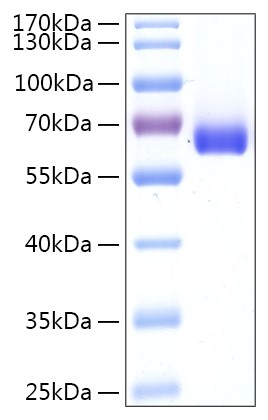Description
Recombinant Human Leukotriene A4 Hydrolase Protein
The Recombinant Human Leukotriene A4 Hydrolase Protein is a biologically active recombinant protein that plays a significant role in various cellular processes and signaling pathways in human biology. This protein is widely employed in immunological research, cell biology studies, protein-protein interaction analyses, and therapeutic development, providing researchers with a reliable tool for investigating Leukotriene A4 Hydrolase function and its implications in health and disease.
This product (SKU: RPCB2137) is produced using Baculovirus-Insect Cells and features a C-His tag for convenient detection and purification. The protein exhibits a calculated molecular weight of 70.7 kDa with an observed molecular weight of 58-68 kDa under denaturing conditions, achieving ≥ 95 % as determined by SDS-PAGE.≥ 95 % as determined by HPLC.. Functional bioactivity has been validated through rigorous quality control assays, confirming its suitability for demanding research applications.
Key Features
| High Purity by Affinity Chromatography | |
| Mammalian & Bacterial Expression Systems | |
| High lot-to-lot consistency via strict QC |
| Product Name: | Recombinant Human Leukotriene A4 Hydrolase Protein |
| SKU: | RPCB2137 |
| Size: | 50 μg |
| Reactivity: | Human |
| Synonyms: | Leukotriene A-4 hydrolase, LTA-4 hydrolase, Leukotriene A(4) hydrolase, Tripeptide aminopeptidase LTA4H |
| Tag: | C-His |
| Expression Host: | Baculovirus-Insect Cells |
| Calculated MW: | 70.7 kDa |
| Observed MW: | 58-68 kDa |
| Gene ID: | 4048 |
| Protein Description: | High quality, high purity and low endotoxin recombinant Recombinant Human Leukotriene A4 Hydrolase Protein (RPCB2137), tested reactivity in Baculovirus-Insect Cells and has been validated in SDS-PAGE.100% guaranteed. |
| Endotoxin: | < 1 EU/μg of the protein by LAL method. |
| Purity: | ≥ 95 % as determined by SDS-PAGE.≥ 95 % as determined by HPLC. |
| Formulation: | Lyophilized from a 0.22 μm filtered solution of PBS, pH 7.4. Contact us for customized product form or formulation. |
| Bio-Activity: | Measured by its ability to cleave the fluorogenic peptide substrate, Arg-7-amido-4-methylcoumarin (R-AMC). The specific activity is >15 pmoles/min/μg. |
| Reconstitution: | Centrifuge the vial before opening. Reconstitute to a concentration of 0.1-0.5 mg/mL in sterile distilled water. Avoid vortex or vigorously pipetting the protein. For long term storage, it is recommended to add a carrier protein or stablizer (e.g. 0.1% BSA, 5% HSA, 10% FBS or 5% Trehalose), and aliquot the reconstituted protein solution to minimize free-thaw cycles. |
| Storage: | Store at -20℃.Store the lyophilized protein at -20℃ to -80 ℃ up to 1 year from the date of receipt. After reconstitution, the protein solution is stable at -20℃ for 3 months, at 2-8℃ for up to 1 week. |
Leukotriene A-4 hydrolase, also known as LTA-4 hydrolase, Leukotriene A (4) hydrolase, LTA4H, and LTA4, is a cytoplasm protein that belongs to the peptidase M1 family. LTA4H hydrolyzes an epoxide moiety of leukotriene A4 (LTA-4) to form leukotriene B4 (LTB-4). This enzyme also has some peptidase activity. The leukotrienes (LTs) are a class of structurally related lipid mediators involved in the development and maintenance of inflammatory and allergic reactions. In the biosynthesis of LTs, arachidonic acid was converted into the unstable intermediate epoxide LTA4, which may, in turn, be conjugated with glutathione to form the spasmogenic LTC4, or hydrolyzed into the pro-inflammatory lipid mediator LTB4 in a reaction catalyzed by Leukotriene A4 hydrolase (LTA4H). LTB4 is a classical chemoattractant of human neutrophils and triggers adherence and aggregation of leukocytes to vascular endothelium, and also modulates immune responses. As a bifunctional zinc metalloenzyme, LTA4H also exhibits an anion-dependant arginyl aminopeptidase activity of high efficiency and specificity in addition to its epoxide hydrolase activity. LTA4H is regarded as a therapeutic target for inflammation.







